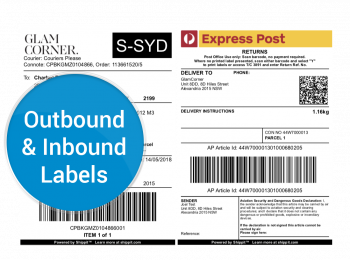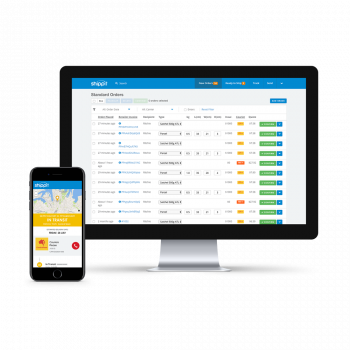20%
10%
30%
How GlamCorner Transformed the Clothes Sharing Economy
Before GlamCorner hurtled its way into the fashion scene in 2012, Australian women were literally wasting truck loads of clothes (and cash) buying single-use fashion items that were only used for one specific occasion. It’s not hard to understand why the designer clothing hire service became one of Australia’s fastest growing startups, with women all over the nation jumping at the gun to borrow new dresses and experience a totally new way of consuming fashion.
But there was just one problem facing GlamCorner as they grew, and it’s a problem that many new businesses overlook in the beginning phases of development. How could GC scale without breaking the bank on shipping costs and wasting time picking, packing and tracking orders?
For GlamCorner, the cost of shipping was a double hit because not only were they facing the uncertain costs of customer delivery, they also have to provide return shipping satchels for every order. This case study will look at how the clothes-sharing service was able to decrease shipping costs and improve picking times and tracking information with the help of Shippit.



GlamCorner’s 3 Biggest Pain Points for Growth
Although GC was growing fast, there were some serious shipping challenges they needed to overcome before they untapped the potential to become one of Australia’s household names in clothes sharing. Let’s take a look at the 3 biggest pain points they experienced as their customer base began to expand.
1. Scaling without added shipping costs
“The more we grew and because shipping costs are one of the largest variable costs to any eCommerce business, we needed to take a hard look at shipping costs as we built scale. As a fashion rental company, we send a prepaid return satchel to our customers with every order, so we take a double hit on shipping for every box going out the door. Hence shipping cost optimisation was a key to our long-term success.”
When they first began operating, GC were relying on one courier for all their different deliveries and returns but eventually shifted to a multi-carrier approach. But this was not the end of their challenges with the CEO stating:
“When we decided we had reached a certain level of scale, it made sense to integrate directly with all these different couriers but each courier had different systems and processes. This was a huge pain point that our software engineering team had to find an answer for.”
Using this new approach to logistics did enable GC to ship nationwide with a range of different couriers, however, it also meant that they had to start picking the best courier according to the jurisdiction and how far they had to send the parcel.
“Sometimes it’s an urgent last minute item, or sometimes things are booked back to back. We had to find a way to use different couriers that wasn’t onerous on our processes or in a way that would drive up costs”, Jones stated.
As we grew, shipping costs became one of our largest variable costs, so we needed to take a hard look at how to reduce it

2. Tracking information from multiple carriers
It’s not efficient to ship parcels all over the nation, or even all over the globe, using one courier. This is why the majority of omni-channel and eCommerce businesses use a multi-carrier approach to logistics, meaning they can book couriers with the correct service level.
But according to Jones, this approach posed many other issues:
“First of all for the end customer, no matter what courier we’re using, they’re getting delivery notifications and are being kept informed about the status of their delivery. That’s very hard to manage when you’re using many couriers.”
The GC software engineering team was spending too much time building and maintaining integrations for each courier, and this was having a flow on effect to all the other tasks that weren’t being done in the business.
3. Inefficient picking and packing, and label printing
If you’re printing thousands of labels for different orders, chopping and changing your processes to accommodate different couriers is a huge pain point. Well at least this is what GC discovered the more they grew.
According to Jones, using a multi-carrier approach was placing unneeded pressure on their pick and pack teams and processes because there wasn’t a streamlined way to fulfil orders for different couriers to ship to different jurisdictions across the country.
“The logistics of picking and packing is highly underestimated in eCommerce. When you’re running a business you have to constantly find efficiencies and a standardised label-printing process is the final piece of the puzzle that often gets overlooked”, Jones stated.


Solving GlamCorner’s shipping challenges
GC isn’t a retailer to shy away from a challenge, so when they engaged Shippit to help solve their logistics issues, we were able to work together to provide solutions to their problems. Take a look below at the 3 ways GC was able to improve the efficiency of their logistics.

Printing dual consignment labels
Now before you let that internal yawn out and move onto that cat video your colleague sent you, hear us out for a minute.
GC doesn’t use a 3rd party logistics provider, so making sure their own dispatching system was efficient as possible was a no-brainer. Before engaging Shippit, Dean recalls his team spending a lot of time fiddling around printing different labels for inbound and outbound parcels. He states:
“We constantly had to print dual consignment labels which is feature no one else had, and Shippit basically built that feature for us.
We now have back to back printing and print outbound labels and inbound label at the same time and stick it on a little satchel inside the outbound box to the customer”
The two labels are printed on the same printer but can be used for different couriers and it also integrates with GC’s backend system so they don’t have to worry about missed information between systems.
“Seconds really matter when it comes to packing times and when you don’t have to muck around with printing labels it saves so much time.
From this feature alone, there was 10% improvement to packing and a 10% reduction in packing costs. We also anticipate this to continue improving with time”
Reduced shipping costs per unit
Dean says that using Shippit has helped GC cut down the cost of shipping each unit by 20%, stating:
“Within the first few months of using Shippit, we’ve only just started adding more couriers but could easily add more, we’re able to ship with the most cost-effective channel every time. Within 2 months we’ve seen a 20% reduction in per unit shipping costs and I’m quite confident we can increase this to 30% this year”
Shippit’s dashboard allows GC to see who’s charging the most and who’s charging the least for courier services so they are able to make better decisions on the most cost effective services. You can read more about how Shippit delivered a 30% reduction in shipping costs in our St Frock case study.
“Shippit’s dashboard helped our Operations and Dispatch teams to focus more on the costs of shipping by having live information when it comes to shipping costs. This allowed us to give more volume to couriers who give us the best rates”, says Dean.
Better tracking without all the hassle
When GC started using Shippit, they were able to consolidate all the tracking information for each courier without having to worry about maintaining a different API for each courier.
“Shippit takes a huge burden off our engineering team because in the past we had to maintain several APIs with several couriers. We didn’t want to waste time building integrations and our system is now receiving live updates of each consignment which is really critical for our business”, says Dean
“This saved us a huge amount of time and has maintained our accuracy when it comes to tracking. Tracking is also fed through to customers in terms of delivery notifications, and maintaining notifications from all couriers is difficult, but Shippit solved this issue for us in a really efficient way.”
Results
- 20% Reduction in per unit shipping costs
- 10% Reduction in packing times
- Delivery tracking reliability and an improved the end customer experience

Get Started Today
Talk to our solutions experts today to start saving time and money on shipping. Book a meeting and we’ll get you up and shipping in a matter of minutes.

